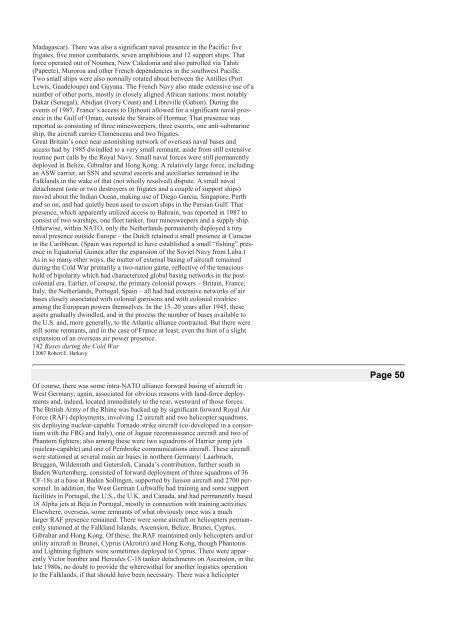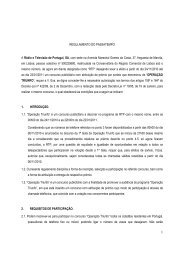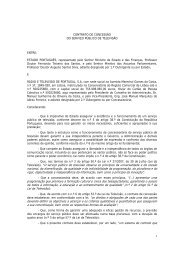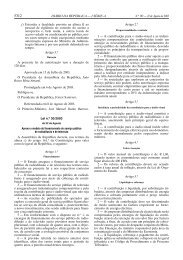6 Bases during the Cold War
6 Bases during the Cold War
6 Bases during the Cold War
Create successful ePaper yourself
Turn your PDF publications into a flip-book with our unique Google optimized e-Paper software.
Madagascar). There was also a significant naval presence in <strong>the</strong> Pacific: fivefrigates, five minor combatants, seven amphibious and 12 support ships. Thatforce operated out of Noumea, New Caledonia and also patrolled via Tahiti(Papeete), Muroroa and o<strong>the</strong>r French dependencies in <strong>the</strong> southwest Pacific.Two small ships were also normally rotated about between <strong>the</strong> Antilles (PortLewis, Guadeloupe) and Guyana. The French Navy also made extensive use of anumber of o<strong>the</strong>r ports, mostly in closely aligned African nations: most notablyDakar (Senegal), Abidjan (Ivory Coast) and Libreville (Gabon). During <strong>the</strong>events of 1987, France’s access to Djibouti allowed for a significant naval presencein <strong>the</strong> Gulf of Oman, outside <strong>the</strong> Straits of Hormuz. That presence wasreported as consisting of three minesweepers, three escorts, one anti-submarineship, <strong>the</strong> aircraft carrier Clemenceau and two frigates.Great Britain’s once near astonishing network of overseas naval bases andaccess had by 1985 dwindled to a very small remnant, aside from still extensiveroutine port calls by <strong>the</strong> Royal Navy. Small naval forces were still permanentlydeployed in Belize, Gibraltar and Hong Kong. A relatively large force, includingan ASW carrier, an SSN and several escorts and auxiliaries remained in <strong>the</strong>Falklands in <strong>the</strong> wake of that (not wholly resolved) dispute. A small navaldetachment (one or two destroyers or frigates and a couple of support ships)moved about <strong>the</strong> Indian Ocean, making use of Diego Garcia, Singapore, Perthand so on, and had quietly been used to escort ships in <strong>the</strong> Persian Gulf. Thatpresence, which apparently utilized access to Bahrain, was reported in 1987 toconsist of two warships, one fleet tanker, four minesweepers and a supply ship.O<strong>the</strong>rwise, within NATO, only <strong>the</strong> Ne<strong>the</strong>rlands permanently deployed a tinynaval presence outside Europe – <strong>the</strong> Dutch retained a small presence at Curacaoin <strong>the</strong> Caribbean. (Spain was reported to have established a small “fishing” presencein Equatorial Guinea after <strong>the</strong> expansion of <strong>the</strong> Soviet Navy from Luba.)As in so many o<strong>the</strong>r ways, <strong>the</strong> matter of external basing of aircraft remained<strong>during</strong> <strong>the</strong> <strong>Cold</strong> <strong>War</strong> primarily a two-nation game, reflective of <strong>the</strong> tenacioushold of bipolarity which had characterized global basing networks in <strong>the</strong> postcolonialera. Earlier, of course, <strong>the</strong> primary colonial powers – Britain, France,Italy, <strong>the</strong> Ne<strong>the</strong>rlands, Portugal, Spain – all had had extensive networks of airbases closely associated with colonial garrisons and with colonial rivalriesamong <strong>the</strong> European powers <strong>the</strong>mselves. In <strong>the</strong> 15–20 years after 1945, <strong>the</strong>seassets gradually dwindled, and in <strong>the</strong> process <strong>the</strong> number of bases available to<strong>the</strong> U.S. and, more generally, to <strong>the</strong> Atlantic alliance contracted. But <strong>the</strong>re werestill some remnants, and in <strong>the</strong> case of France at least, even <strong>the</strong> hint of a slightexpansion of an overseas air power presence.142 <strong>Bases</strong> <strong>during</strong> <strong>the</strong> <strong>Cold</strong> <strong>War</strong>İ 2007 Robert E. HarkavyOf course, <strong>the</strong>re was some intra-NATO alliance forward basing of aircraft inWest Germany; again, associated for obvious reasons with land-force deploymentsand, indeed, located immediately to <strong>the</strong> rear, westward of those forces.The British Army of <strong>the</strong> Rhine was backed up by significant forward Royal AirForce (RAF) deployments, involving 12 aircraft and two helicopter squadrons,six deploying nuclear-capable Tornado strike aircraft (co-developed in a consortiumwith <strong>the</strong> FRG and Italy), one of Jaguar reconnaissance aircraft and two ofPhantom fighters; also among <strong>the</strong>se were two squadrons of Harrier jump jets(nuclear-capable) and one of Pembroke communications aircraft. These aircraftwere stationed at several main air bases in nor<strong>the</strong>rn Germany: Laarbruch,Bruggen, Wildenrath and Gutersloh. Canada’s contribution, fur<strong>the</strong>r south inBaden Wurtemberg, consisted of forward deployment of three squadrons of 36CF-18s at a base at Baden Sollingen, supported by liaison aircraft and 2700 personnel.In addition, <strong>the</strong> West German Luftwaffe had training and some supportfacilities in Portugal, <strong>the</strong> U.S., <strong>the</strong> U.K. and Canada, and had permanently based18 Alpha jets at Beja in Portugal, mostly in connection with training activities.Elsewhere, overseas, some remnants of what obviously once was a muchlarger RAF presence remained. There were some aircraft or helicopters permanentlystationed at <strong>the</strong> Falkland Islands, Ascension, Belize, Brunei, Cyprus,Gibraltar and Hong Kong. Of <strong>the</strong>se, <strong>the</strong> RAF maintained only helicopters and/orutility aircraft in Brunei, Cyprus (Akrotiri) and Hong Kong, though Phantomsand Lightning fighters were sometimes deployed to Cyprus. There were apparentlyVictor bomber and Hercules C-18 tanker detachments on Ascension, in <strong>the</strong>late 1980s, no doubt to provide <strong>the</strong> wherewithal for ano<strong>the</strong>r logistics operationto <strong>the</strong> Falklands, if that should have been necessary. There was a helicopterPage 50
















